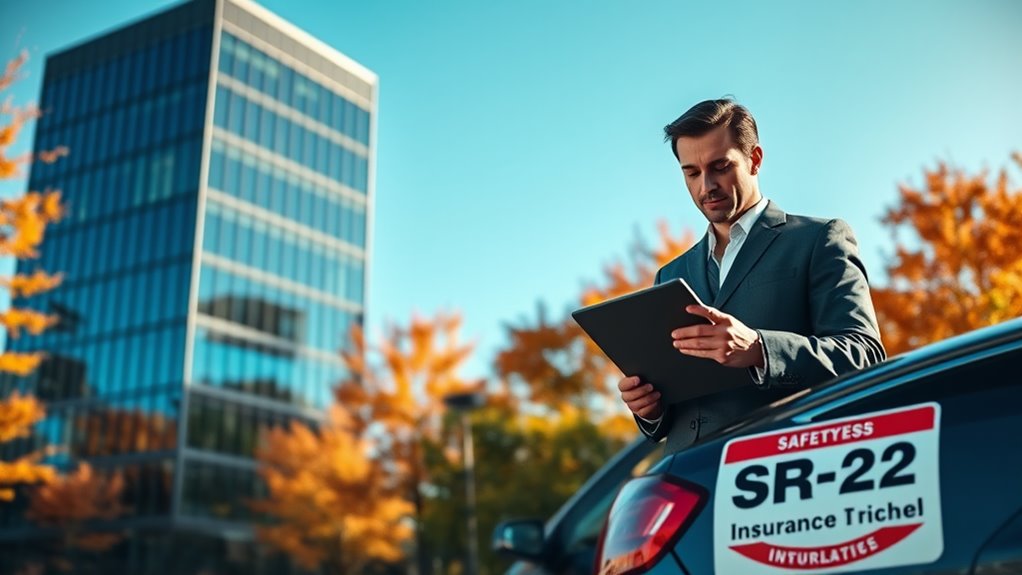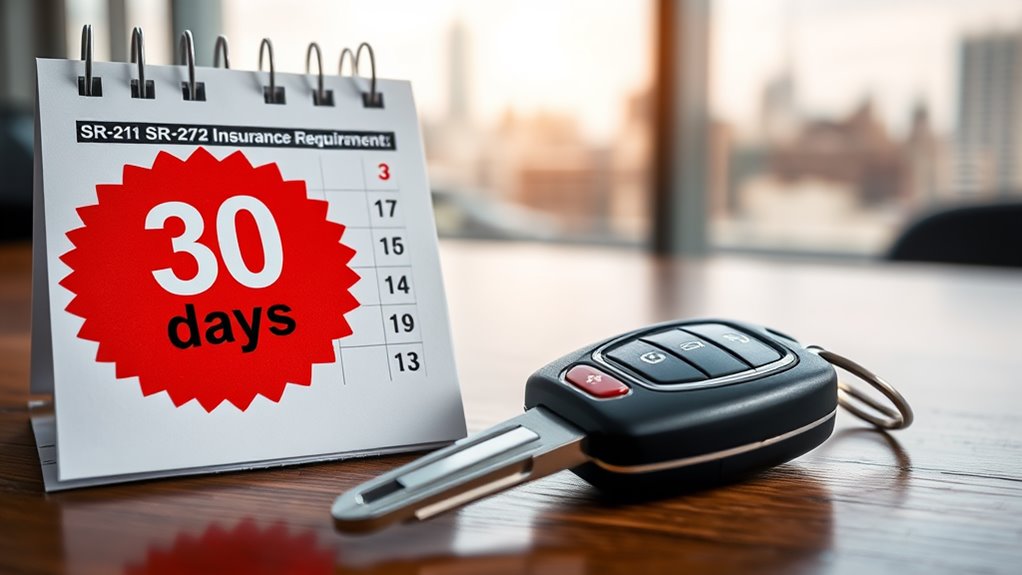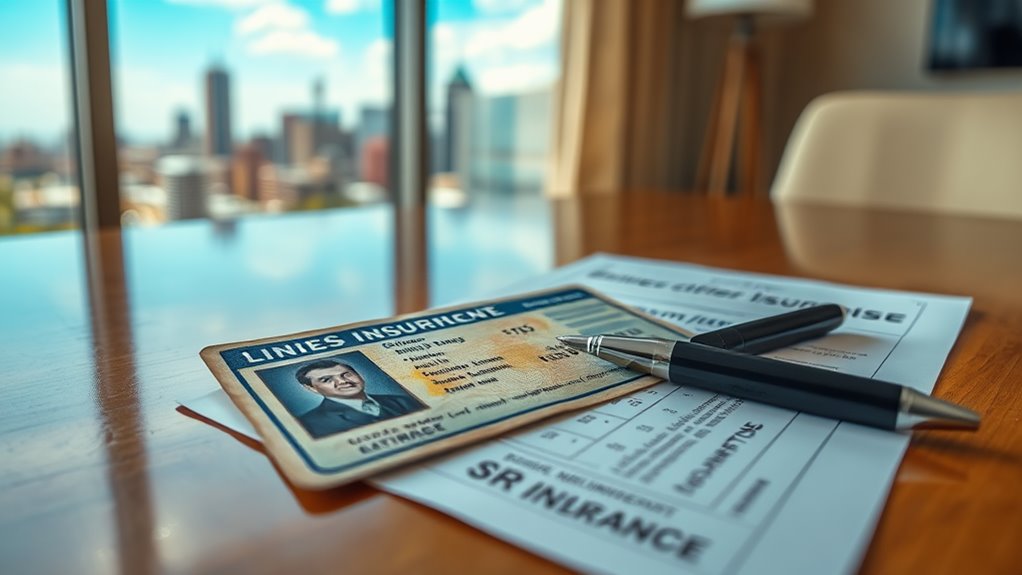Imagine maneuvering the complex maze of Illinois traffic regulations, where SR-22 insurance acts as an essential lifeline for high-risk drivers. If you’ve faced serious driving violations, you might need this state-mandated filing to prove you meet minimum liability coverage. Understanding who needs it and the implications on your insurance premiums can greatly impact your driving future. But what happens if you fail to maintain compliance?
Key Takeaways
- SR-22 insurance is a state-mandated filing proving minimum liability coverage for high-risk drivers in Illinois.
- Drivers convicted of DUI, DWI, or multiple moving violations may be required to obtain SR-22 insurance.
- Minimum liability coverage for SR-22 in Illinois includes $25k per person, $50k per accident, and $20k for property damage.
- Failure to maintain SR-22 coverage can lead to license suspension, fines, and higher insurance premiums.
- Costs for SR-22 insurance can increase premiums by 15% to 80%, making comparison shopping essential for the best rates.
What Is SR-22 Insurance?

SR-22 insurance might be a term you’ve heard if you’re maneuvering the aftermath of serious driving violations in Illinois.
It’s essential to understand that SR-22 isn’t an insurance policy itself; rather, it’s a state-mandated filing proving you have minimum liability coverage. Your insurer files this directly with the Illinois DMV to verify your compliance, specifically required for high-risk drivers after violations like DUI or license suspensions.
Typically mandated for 3 to 5 years, the SR-22 guarantees your financial responsibility post-license reinstatement. States dictate SR-22 requirements, so it’s crucial to check the specific regulations in Illinois. To initiate the process, you must contact your insurance provider to add the SR-22 endorsement, which involves a non-refundable filing fee and requires timely submission to avoid license revocation.
Who Needs SR-22 Insurance in Illinois?
If you’ve been convicted of a DUI or DWI in Illinois, you’ll likely need SR-22 insurance to prove your financial responsibility. Additionally, multiple moving violations can trigger the requirement for an SR-22 filing as well. Understanding these circumstances is essential for ensuring compliance and maintaining your driving privileges. In Illinois, the liability insurance is often the minimum requirement needed to fulfill the SR-22 obligation.
DUI or DWI Convictions
When a driver faces a DUI or DWI conviction in Illinois, they typically find themselves needing to secure SR-22 insurance. This requirement arises following a license suspension, as mandated by the Illinois Secretary of State, which classifies the driver as high-risk.
SR-22 isn’t a standalone policy; it confirms you have the state-mandated liability coverage of $25,000 per person, $50,000 per accident, and $20,000 for property damage. Your insurance provider must file the SR-22 directly with the state.
Failure to maintain this coverage can lead to immediate license suspension. Depending on the severity of the violation, you may need to uphold this for three to five years, with continuous coverage essential to avoid penalties or reinstatement fees.
Multiple Moving Violations
Drivers with multiple moving violations in Illinois may also find themselves in need of SR-22 insurance, similar to those facing DUI or DWI convictions.
If you accumulate three or more moving violations within a 12-month period, the Illinois Secretary of State may designate you as a high-risk driver. Violations such as excessive speeding, running red lights, or at-fault accidents can trigger this requirement.
Your SR-22 insurance must meet minimum liability limits of $25k/$50k for bodily injury and $20k for property damage. Keep in mind, your coverage must remain active; lapses can result in license suspension.
Additionally, any new violations reset the compliance timeline, making it essential to maintain a clean driving record during this period.
Coverage Requirements for SR-22 Insurance
When considering SR-22 insurance in Illinois, you’ll need to understand the minimum liability coverage mandated by the state.
This includes $25,000 per person for injury or death, $50,000 per accident for multiple parties, and $20,000 for property damage.
Additionally, if you don’t own a vehicle, a non-owner SR-22 may be necessary to meet compliance requirements.
Minimum Liability Coverage
In Illinois, minimum liability coverage for SR-22 insurance mandates specific financial limits to guarantee adequate protection for all parties involved in an accident.
You need at least $25,000 for bodily injury per person and $50,000 per accident, ensuring compensation for multiple injuries or fatalities. Additionally, property damage liability requires a minimum of $20,000 to cover damage to others’ property.
Uninsured motorist coverage is also mandatory, with the same limits as bodily injury. Compliance with these requirements is essential, as the SR-22 certificate verifies your adherence to these limits.
If you fail to maintain this coverage, it can lead to serious consequences, including license suspension, highlighting the importance of understanding these minimum liability coverage requirements.
Non-Owner SR-22 Requirements
Non-owner SR-22 insurance requirements are vital for individuals who need to maintain coverage without owning a vehicle. Here are key details to reflect on:
- You must carry SR-22 if mandated by the state due to serious violations like DUIs.
- Non-owner policies are required when you don’t own a vehicle but need coverage to reinstate your license.
- This insurance applies when using vehicles not registered in your name, such as rented or borrowed ones.
- You must maintain coverage continuously for a minimum period, typically three years.
Filing the SR-22 form with your state’s DMV is a significant step, ensuring compliance and protecting you from further penalties.
Understanding these requirements will help you navigate your insurance needs effectively.
Policy Types Consideration
Understanding the various policy types for SR-22 insurance is essential for ensuring compliance and maintaining necessary coverage. In Illinois, the SR-22 certificate confirms that you meet the minimum financial responsibility requirements after serious motor violations.
There are several types to evaluate: the Owner SR-22, applicable if you own a vehicle; the Non-owner SR-22, suited for those without a vehicle; the Operator SR-22, for commercial drivers; and the Fleet SR-22 for businesses with multiple vehicles.
Each type meets state regulations, ensuring you maintain continuous coverage. Remember, failing to keep your SR-22 active can lead to penalties, reinstatement fees, or even license suspension, so choose the right policy type carefully to avoid complications.
How to File for SR-22 Insurance
Filing for SR-22 insurance in Illinois requires a clear understanding of the necessary steps to secure compliance and avoid complications. Here’s what you need to do:
- Contact your insurance provider to verify their SR-22 filing capability.
- Prepare required documentation, including court orders and personal identification.
- File the SR-22 form with your insurer, making sure they submit it electronically to the Illinois Secretary of State.
- Maintain continuous coverage to prevent policy lapses and secure compliance with state requirements.
Duration of SR-22 Insurance Requirement

Once you’ve successfully filed for SR-22 insurance in Illinois, it’s important to be aware of how long you’ll need to maintain this coverage.
Generally, you’re required to hold SR-22 insurance for a minimum of three continuous years. The SR-22 must remain with the Secretary of State throughout this period, and any lapse in coverage can lead to immediate suspension of your driver’s license and vehicle registration.
You must maintain SR-22 insurance for at least three years without any lapses to avoid license suspension.
Additionally, the duration may vary based on your driving record at the time of the requirement. If you fail to maintain coverage, you may face a reinstatement hearing and incur extra fees.
Ensuring continuous compliance is essential to avoid these legal and financial repercussions.
Maintaining Compliance With SR-22 Insurance
Maintaining compliance with SR-22 insurance in Illinois is essential for avoiding severe penalties, including license suspension.
To guarantee your compliance, consider these key factors:
- Confirm your insurer offers SR-22 filings before purchasing a policy.
- Keep your policy active without lapses or cancellations throughout the required period.
- Verify that your policy meets Illinois’ minimum liability coverage standards: $25,000 bodily injury per person, $50,000 per accident, and $20,000 property damage.
- Notify your insurer immediately of any changes to your address or vehicle.
Penalties for Non-Compliance With SR-22 Insurance
Failing to comply with SR-22 insurance requirements in Illinois can lead to significant repercussions that affect your driving privileges and financial stability.
An immediate license suspension occurs until you achieve compliance, along with fines that can reach up to $1,000 for uninsured driving offenses. If you’re a repeat offender, the penalties escalate, including a mandatory three-year SR-22 filing period.
Immediate license suspension and fines up to $1,000 await those who fail to comply with SR-22 requirements in Illinois.
Additionally, your license plate may be suspended for three to four months. Non-compliance also incurs higher insurance premiums due to a high-risk classification, further straining your finances.
Ultimately, the repercussions not only disrupt your ability to drive but also create long-term financial consequences that can affect your employment opportunities and overall quality of life.
Reinstatement Process Following License Suspension

When your license is suspended in Illinois, managing the reinstatement process requires careful attention to specific administrative steps and documentation.
To successfully navigate this process, you’ll need to:
- Attend a formal hearing with the Illinois Secretary of State office.
- Submit documentation proving your rehabilitation, including treatment completion and character references.
- Present evidence of changed circumstances, such as stable employment and an improved driving record.
- Guarantee compliance with statutory requirements, like completing DUI classes and paying fines.
The hearing officer will review your case, and the outcome will determine your eligibility for reinstatement.
Be prepared for possible additional stipulations that may accompany approval. Following these steps diligently will facilitate a smoother reinstatement experience.
Impact of SR-22 Insurance on Premiums
When you obtain SR-22 insurance in Illinois, expect a significant increase in your premiums, often ranging from 15% to 40%.
This rise is largely due to your classification as a high-risk driver, which insurers use to assess your overall risk profile.
Additionally, these elevated rates can persist for the required three-year coverage period, impacting your financial planning.
Increased Premium Costs
Although you may need an SR-22 to meet state requirements after certain driving violations, it often comes with markedly increased premium costs.
These costs can greatly impact your budget, and here’s what you should know:
- Premium Increase: Expect an annual hike of $400-$1,000.
- Comparison Basis: Your SR-22 premiums could be 50% to 80% higher than standard rates.
- Cost Factors: Age, driving history, and coverage type all influence your premium.
- Insurer Variations: Different providers may offer varying rates, making it essential to compare options.
Thus, while the SR-22 filing fee may be minimal, the overall financial burden from increased premiums can be substantial, urging you to shop wisely for the best coverage.
High-Risk Classification Effects
Being classified as a high-risk driver greatly impacts your insurance premiums, often leading to considerable financial repercussions. Insurance companies assess your driving history, including violations like DWI/DUI and multiple moving violations, to determine your risk level. As a result, you’ll likely face markedly higher premiums compared to standard-risk drivers.
Additionally, your insurance options may be limited, as some providers may not cover high-risk classifications at all. Maintaining continuous coverage is essential; if your policy lapses, your insurer must notify the state, potentially leading to severe penalties.
Consequently, the financial implications of high-risk classification stretch beyond just increased premiums, affecting your overall insurance affordability and long-term financial planning.
Duration of Rate Impacts
The duration of rate impacts from SR-22 insurance in Illinois can greatly affect your financial landscape, especially if you’ve faced a DUI or similar infractions. Typically, you’ll need to maintain SR-22 coverage for three years, which directly influences your premiums.
- Continuous coverage is mandatory; lapses can lead to further penalties.
- Premiums tend to rise considerably due to your classification as a high-risk driver.
- Rates can vary widely among different insurers, so shopping around is vital.
- A one-time filing fee of $15-$25 may also increase your overall costs.
Understanding these factors is essential as they shape your financial obligations during the SR-22 period and can have long-lasting implications on your insurance rates.
Tips for Managing SR-22 Insurance Costs
Managing SR-22 insurance costs effectively requires a strategic approach to various factors that influence your premiums. Start by maintaining a clean driving record; avoiding traffic violations can greatly lower your rates over time.
Resolve any outstanding tickets promptly and consider taking defensive driving courses to demonstrate your commitment to safety.
Optimize your coverage by raising deductibles on collision and all-encompassing policies while removing optional coverages for low-value vehicles. It’s also wise to improve your credit score to access better rates.
Always compare quotes from multiple insurers and verify they directly file your SR-22 with the Illinois SOS.
Finally, be proactive in meeting compliance requirements to avoid unnecessary lapses in coverage, which can further inflate your costs.
Frequently Asked Questions
Can I Drive With an SR-22 if My License Is Suspended?
You can’t drive with an SR-22 if your license is suspended. While the SR-22 shows you have insurance, it doesn’t grant driving privileges until you complete the necessary steps to reinstate your license.
Does an SR-22 Affect My Credit Score?
When it comes to your credit score, SR-22 doesn’t directly impact it. However, if you miss payments or fall behind, you could find yourself in hot water, affecting your credit down the line.
Can I Change Insurers While Having an SR-22?
Yes, you can change insurers while having an SR-22. Just make certain your new provider handles the necessary filings and maintains continuous coverage to avoid penalties. Cancel your old policy only after securing the new one.
Will My SR-22 Go Away After Three Years Automatically?
Your SR-22 won’t automatically go away after three years. You must guarantee the state removes the requirement first; otherwise, any lapse or improper cancellation can lead to legal issues or license suspension.
Is There a Grace Period for SR-22 Coverage Lapses?
There isn’t a formal grace period for SR-22 coverage lapses. If you let your coverage lapse, it can lead to immediate license suspension and other complications, so timely renewal is essential to maintain compliance.
Conclusion
Maneuvering the world of SR-22 insurance in Illinois can feel like steering through a stormy sea, but understanding its requirements and implications can help you chart a smoother course. By staying compliant and managing your coverage wisely, you can keep your premiums from ballooning and your driving privileges intact. Just remember, maintaining that steady course of continuous coverage is your best compass to avoid penalties and guarantee safe travels on the road ahead.
